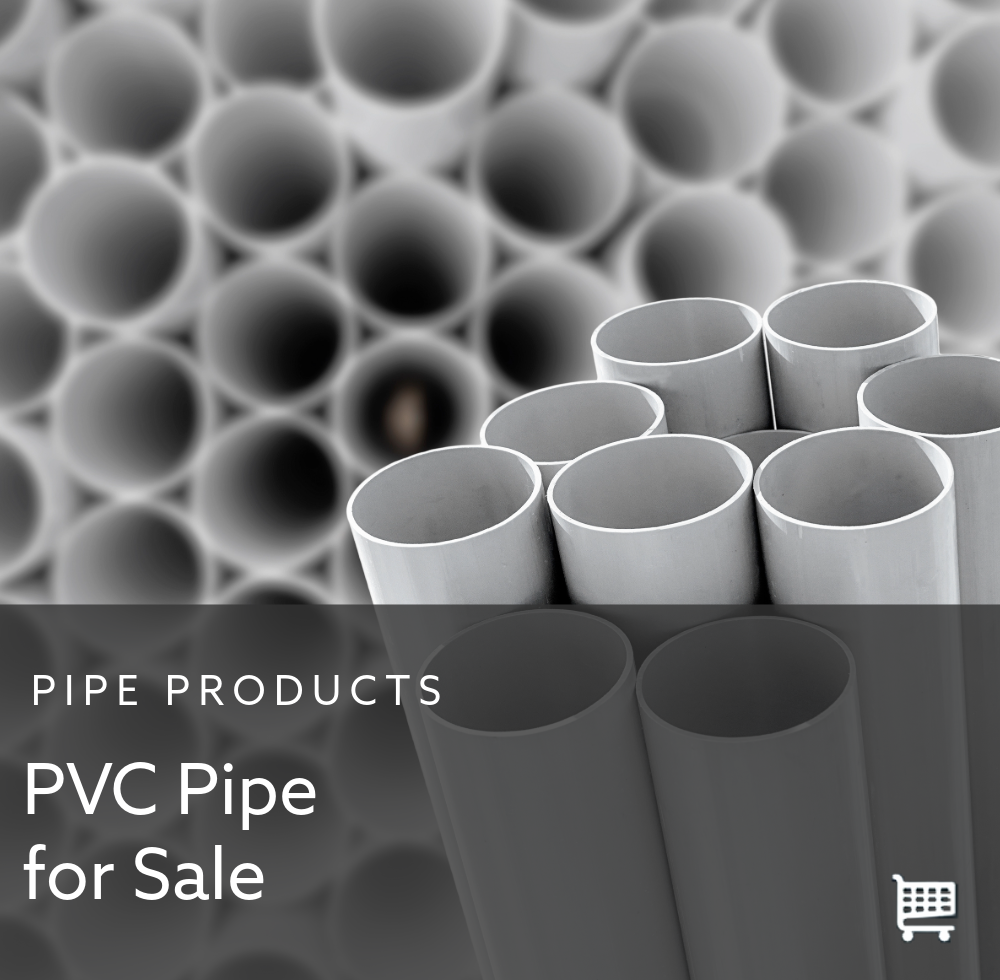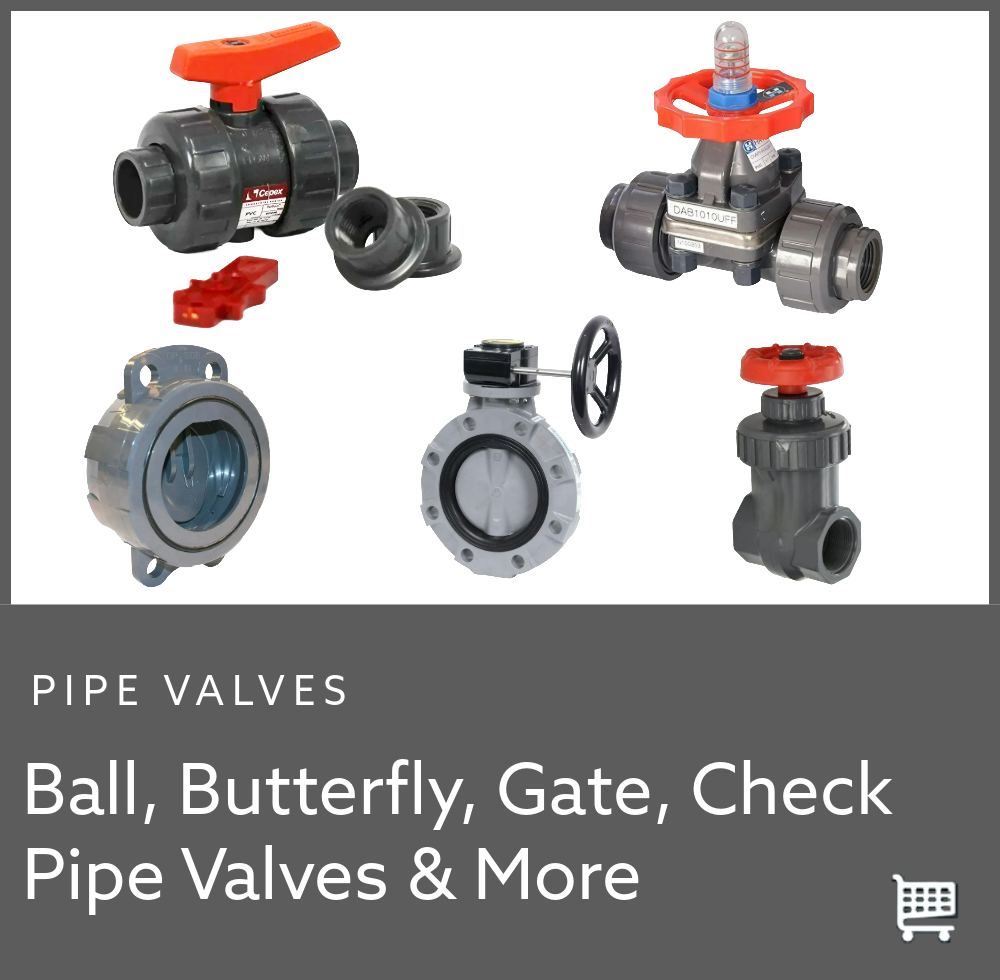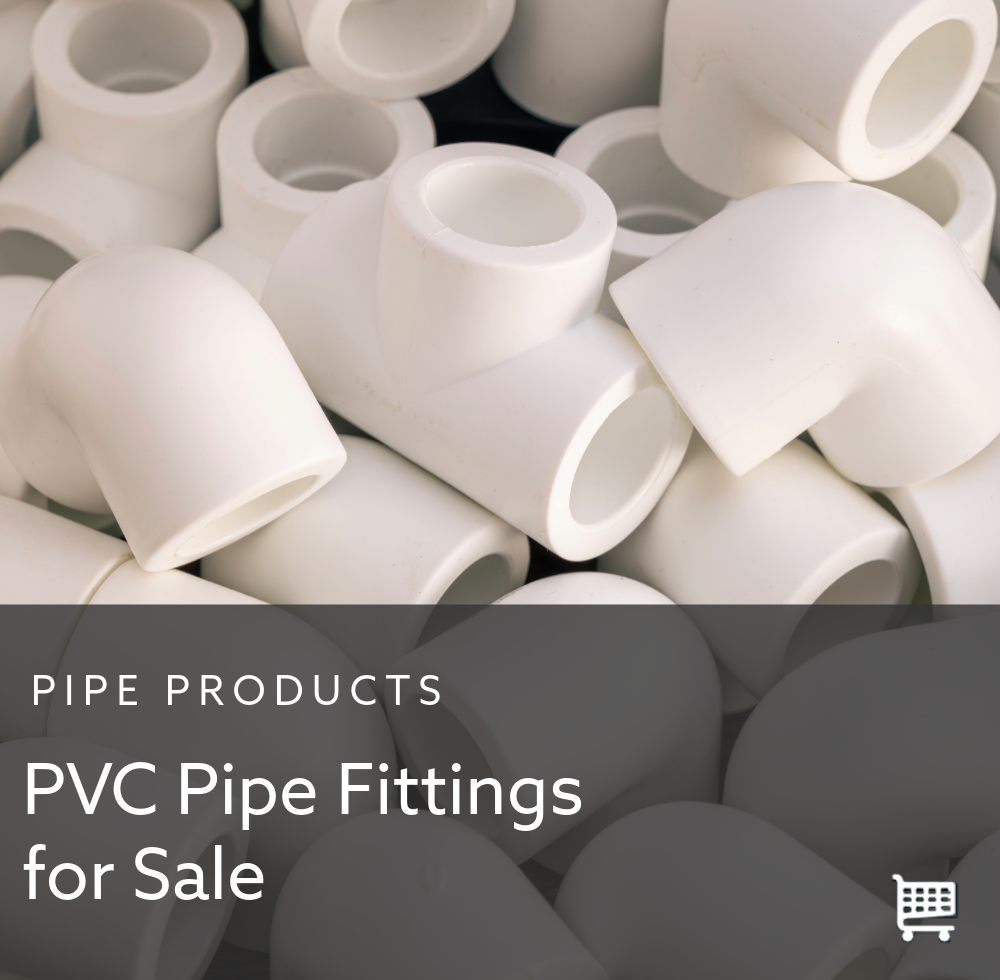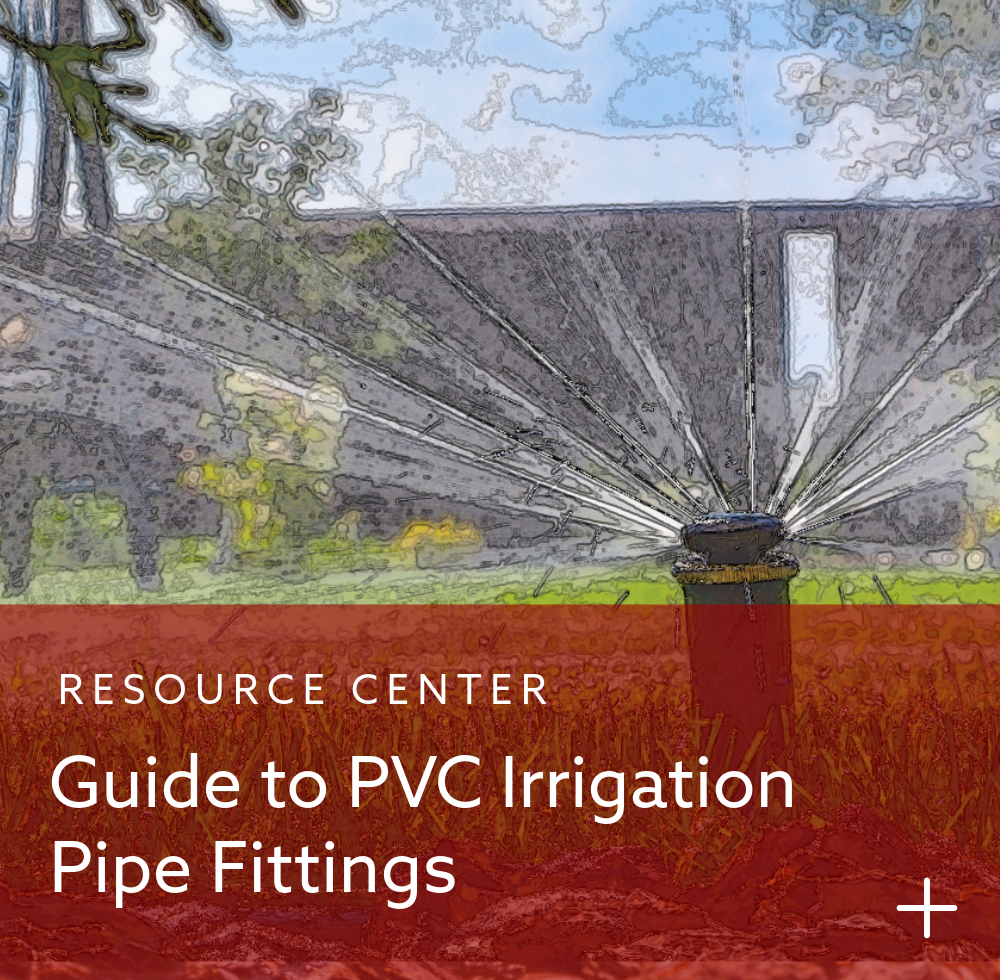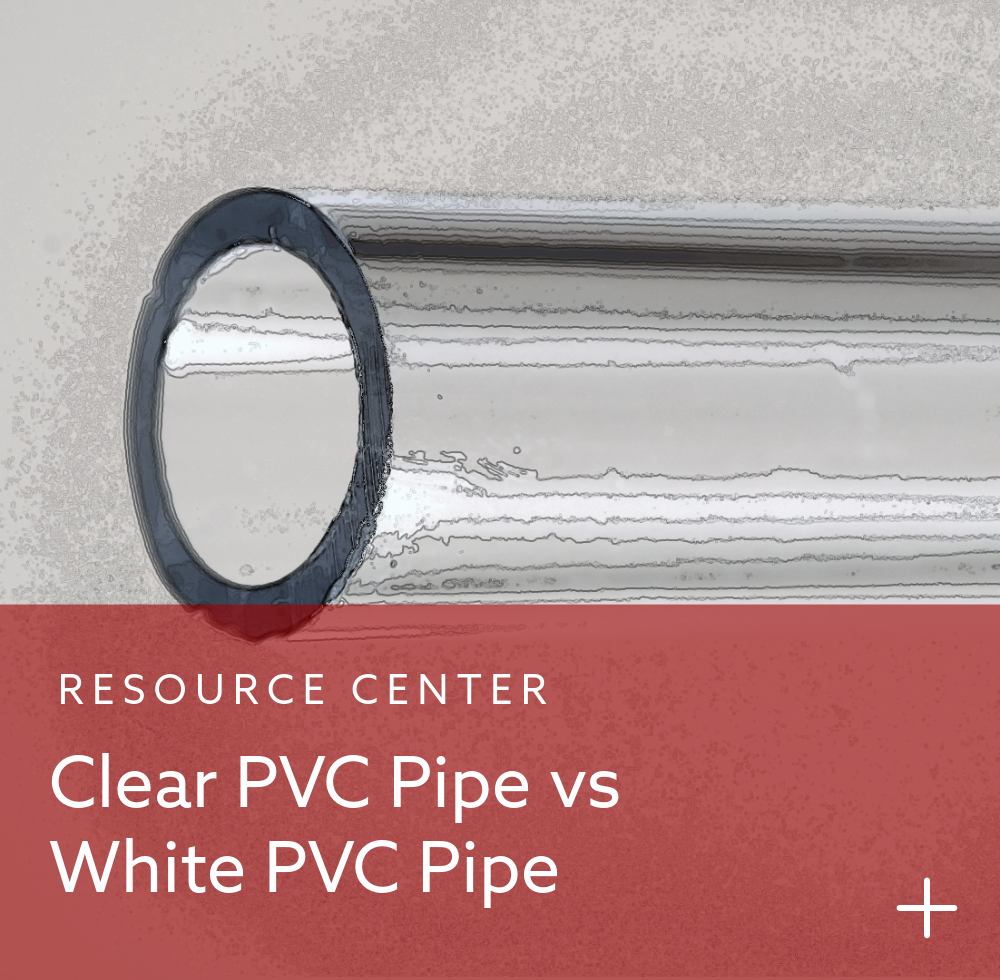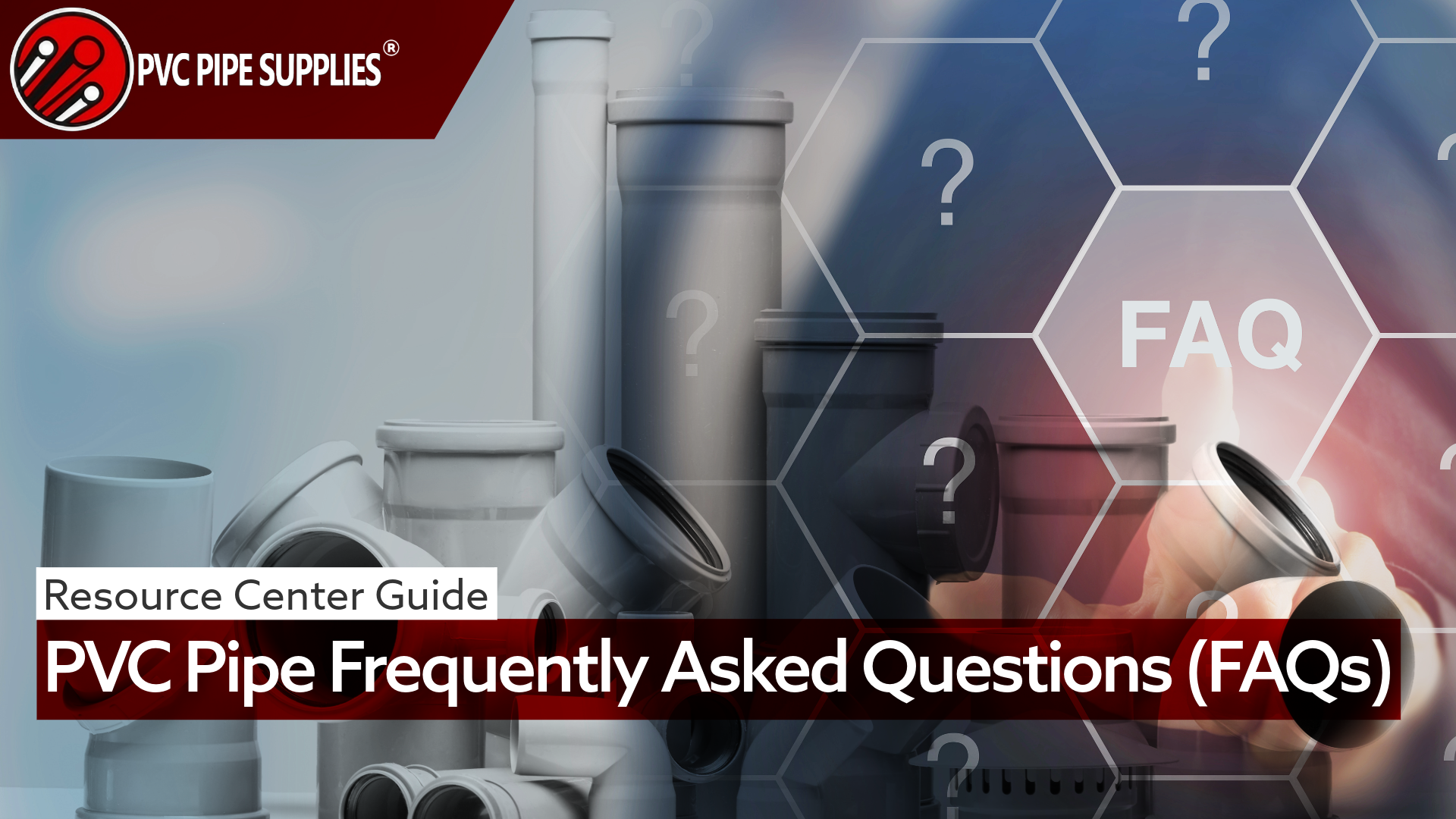 |
PVC pipes and fittings are used in a wide range of projects, from home repairs and plumbing to commercial and municipal infrastructure to industrial facilities. This FAQ page is your go-to resource for the most common questions about PVC pipe, fittings, valves, accessories, best practices, environmental impacts, and safety. Whether you’re a DIYer, contractor, or industry professional, you’ll find detailed, organized answers to your questions. |
General Questions About PVC
PVC stands for Polyvinyl Chloride, a versatile and widely used synthetic (man-made) thermoplastic polymer. It is produced through the polymerization of vinyl chloride monomers. As a thermoplastic, it can be melted, molded into various shapes like pipes and fittings, and then cooled to a solid state without losing its core properties. These characteristics and the manufacturing process make it possible to create a vast range of PVC products. Key properties of PVC include: general durability, high strength-to-weight ratio, and strong resistance to corrosion, chemicals, and weathering, making it a long lasting and reliable material for countless applications. PVC is also lightweight, which simplifies transportation and installation.
While often used interchangeably, the term PVC can refer to several variations in material or formulation, where each is engineered for specific performance needs. Understanding these differences can be important in selecting the right material for a set project or goal.
- PVC-U (Unplasticized PVC): Often referred to simply as rigid PVC or uPVC, this is the most common form of PVC pipe. It contains no plasticizers, which gives it high rigidity and strength. Its resistance to chemical corrosion also makes it ideal for water distribution, drainage systems, and industrial fluid transport.
- PVC-O (Molecularly Oriented PVC): This type of PVC undergoes a manufacturing process that aligns its molecules to result in a pipe with improved tensile strength and fatigue resistance. PVC-O pipes have thinner walls but can handle higher pressure ratings than standard PVC-U, making them excellent options for high pressure water mains and irrigation systems.
- PVC-M (Modified PVC): PVC-M is modified with agents that increase its impact and crack resistance. While it maintains good rigidity, its primary advantage is toughness, which makes it suitable for buried pipelines in areas with unstable ground or where impact damage is a concern.
- CPVC (Chlorinated PVC): Chlorinated Polyvinyl Chloride, or CPVC, is created by putting PVC through a further chlorination process. This process increases its temperature resistance and allows CPVC to handle hot water and more aggressive industrial chemicals. CPVC is commonly used for hot and cold water supply lines in residential and commercial plumbing, as well as in industrial liquid handling systems where higher temperatures or more aggressive solutions are often a factor.
The primary difference between Schedule 40 and Schedule 80 PVC pipe is the wall thickness. Schedule 80 pipe has a thicker wall than Schedule 40 pipe of the same nominal pipe size. This difference has a direct impact on their performance and, therefore, the applications each should be used for:
- Wall Thickness and Pressure Rating: Due to its thicker wall, Schedule 80 PVC can handle higher internal pressure (PSI) than Schedule 40. This makes it the preferred choice for industrial applications, chemical processing, and any PVC compatible plumbing system operating under higher pressures. Schedule 40 is suitable for lower pressure applications like residential drainage, irrigation, and cold water supply.
- Color: While not a universal rule, Schedule 40 PVC is typically white, and Schedule 80 is often gray. This color coding helps professionals to potentially identify the pipe schedule on a job site quickly.
- Usage Scenarios: Use Schedule 40 for standard home plumbing (DWV - Drain, Waste, Vent), irrigation, and creative DIY projects. Choose Schedule 80 in commercial plumbing, manufacturing facilities, and any application where the pipe will be exposed to higher stress or used to transport corrosive fluids under pressure.
See our article here for more on the differences between Schedule 40 and Schedule 80 PVC piping.
PVC is made from a combination of raw materials, primarily salt (which yields chlorine) and petroleum or natural gas (which yields ethylene). These are combined to create a vinyl chloride monomer (VCM). Through a process called polymerization, these monomers are linked together to form a PVC resin, which is a fine white powder in appearance. For rigid PVC products like pipes, this resin is blended with additives for stability and durability, then heated and forced through a die/mold in a process called extrusion. This forms the pipe or fitting shape, which is then cooled, cut, and prepared for use. Flexible PVC is created using a similar process and by adding plasticizers to the resin, which gives the material its characteristic flexibility.
The properties and resulting versatility of PVC allow it to be used in a vast number of applications across many sectors. Its combination of strength, durability, and cost effectiveness makes it a preferred plumbing material for:
- Plumbing: Used heavily in residential and commercial buildings for both pressurized water supply lines (hot and cold, using CPVC) and non-pressure applications like drain, waste, and vent (DWV) systems.
- Drainage: Ideal for stormwater handling, culverts, and other water or waste management systems due to its smooth interior surface that promotes flow.
- Irrigation and Agriculture: A primary choice for delivering water to crops and landscapes due to its ability to resist corrosion from weather, fertilizers, and chemicals.
- Electrical Conduits: PVC provides excellent protection for electrical wiring that can shield it from moisture, impact, and corrosion both above and below ground.
- Industrial Applications: Schedule 80 PVC and CPVC are used to transport various chemicals and handle high pressure systems in manufacturing and industrial facilities.
- DIY Projects: Its ease of use and low cost make furniture grade PVC a popular material for creative builds, furniture, garden structures, and custom solutions around a home or business.
PVC pipe is known for its exceptional longevity. When installed correctly, even buried PVC pipes have a design life that can reach and exceed 100 years. Several factors can impact the lifespan of PVC, including:
- UV Exposure: Direct sunlight can degrade the outer layer of PVC over time, making it more brittle. For outdoor applications, it's recommended to paint the pipe with a light colored, water based PVC-rated latex paint or use UV resistant PVC.
- Burial Conditions: Properly buried pipe is protected from UV rays and extreme temperature changes, contributing to a longer service life. The stability of the surrounding soil can also play a role.
- Water Quality and Pressure: While highly resistant to chemicals, certain extremely aggressive fluids or constant high pressure surges can affect life expectancy. Here, using the correct schedule and type of pipe material for the application is critical.
PVC offers several distinct advantages and some disadvantages when compared to traditional materials.
- PVC vs Metal (Steel, Iron): PVC is much lighter, making it easier and cheaper to transport and install. It is also immune to rust and most forms of corrosion that plague metal pipes. However, metal pipes typically offer superior physical strength and can withstand much higher temperatures.
- PVC vs Copper: PVC is significantly more affordable than copper. It is also simpler to install, often requiring solvent cement or making use of gaskets or flanges rather than soldering. Copper is naturally biostatic, which can inhibit bacterial growth, but it is susceptible to corrosion from acidic water.
- PVC vs Wood: As a building material, PVC is impervious to rot, moisture damage, and pests like termites, which are major weaknesses of wood. Wood is a natural, renewable resource, whereas PVC is a petroleum based product.
Yes, PVC is inherently waterproof. Its non-porous surface prevents water absorption, making it an excellent material for fluid transport and applications that require moisture resistance. This property makes it perfectly suitable for both underground and outdoor use. When used underground, PVC's resistance to soil chemistry and moisture provides a long service life. For outdoor, above ground applications, the main concern is to protect the pipe from years of sunlight exposure and avoid UV damage of its outer surface that can lead to weakening.
Understanding the different joint systems for PVC pipes will allow you to choose the best option for your specific application. The most common methods for joining PVC include solvent cement, gasketed joints, and various transition joints.
- Solvent Cement Joints: This is the most common method for joining PVC pipe and fittings and creates a permanent chemical weld. The process uses a primer to clean and soften the piping surfaces, followed by a layer of solvent cement. When assembled, the cement fuses the two pieces into a single, seamless unit. This method is ideal for pressurized water systems and drainage applications where a permanent, high strength bond is required.
- Gasketed Joints: Gasketed joints are widely used for underground pipelines, such as water mains and sewer lines. This connection option features a flexible synthetic gasket inside the pipe's bell end. The spigot end of the connecting pipe is lubricated and pushed into the belled end, creating a strong, watertight seal that remains flexible. This flexibility allows the pipeline to tolerate ground movement, expansion, and contraction without leaking, making it a reliable choice for buried plumbing systems.
- Transition Joints: When connecting PVC to other materials like metal or to equipment that may need removed, transition joints are necessary. Common types include:
- Threaded Adapters: These fittings have one solvent weld end and one threaded end (male or female) to connect with threaded metal pipes, fittings, or equipment.
- Flanges: Flange adapters allow you to bolt a PVC pipe to a flanged pipe, valve, or pump and create a strong but disconnectable joint.
- Unions: Unions are three part fittings that allow easy disconnection of a pipe section for maintenance or repairs without cutting the pipe.
The letters and numbers printed on PVC pipes are not random. They provide critical information about the pipe's specifications and intended uses. Knowing these markings can help you select the correct product that meets safety and performance standards for your project. Common PVC pipe markings include:
- Manufacturer's Name or Trademark: Identifies the company that produced the pipe.
- Pipe Size: The nominal pipe size NPS (e.g., “2 inch”) indicates the diameter and compatibility with fittings of the same size.
- Material Designation: This code specifies the type of PVC material, such as "PVC 1120," which relates to the material's pressure rating, temperature resistance, and durability.
- Standard Approvals: A marking like "ASTM D1785" indicates that the pipe was manufactured and tested according to the standards set by ASTM International for quality and performance.
- Pressure Rating or Schedule: The pipe will be marked with either a pressure rating in PSI (pounds per square inch) or a schedule number (e.g., "Schedule 40" or "Sch 80"). This tells you the maximum internal pressure the pipe can safely handle.
- Potable Water Certification: If the pipe is safe for drinking water, it will bear a certification mark from an organization like NSF International (e.g., "NSF-pw" or "NSF/ANSI 61").
While there is no universally accepted color code for PVC pipes, the industry does follow some common practices that can help you identify a pipe and its likely application. However, you should always rely on the printed markings for accurate specifications. Common color conventions include:
- White: Typically used for potable water lines (both pressure pipe and DWV - Drain, Waste, Vent), and irrigation.
- Gray: Most often associated with Schedule 80, electrical conduit, and industrial piping that requires higher pressure ratings.
- Green: Commonly used for sewer lines and drain pipes.
- Blue: Often used for potable water mains to distinguish them from other buried lines.
- Purple: Reserved for reclaimed or non-potable water lines, such as in irrigation systems that use recycled water.
Advanced Properties and Special Uses
Pressure classes and rating codes help you identify a pipe's ability to withstand internal pressure. Understanding them can help you select the right pipe for your system.
- SDR (Standard Dimension Ratio): This ratio is calculated by dividing the pipe's outside diameter by its wall thickness. A lower SDR number means a thicker wall and a higher pressure rating. For example, an SDR 13.5 pipe has a thicker wall and can handle more pressure than an SDR 26 pipe of the same diameter. This rating system is useful because it provides a consistent understanding of a pipe’s pressure capability across different pipe sizes within the same SDR class.
- PN (Pressure Nominal): Common in Europe and other regions that use metric standards. The PN rating indicates the nominal pressure in bars that a pipe can withstand at a specific temperature (usually 20°C). For example, a PN 10 pipe is rated for 10 bars of pressure.
When selecting a pipe, always choose a pressure class or rating that exceeds your system's maximum operating pressure to ensure a safe and reliable operation.
Temperature and pressure are directly related. As the temperature of the fluid inside the pipe increases, the pipe's ability to handle pressure decreases.
- Standard PVC (Schedule 40 and 80) should not be used for applications where temperatures exceed 140°F (60°C).
- CPVC (Chlorinated PVC) should not be used for applications where temperatures exceed 200°F (93°C).
Temperature has a direct impact on the strength and pressure performance of PVC pipe. As the temperature of the fluid inside the pipe increases, the PVC material softens slightly, which reduces its ability to withstand pressure. Standard PVC pressure ratings reported for pipe and fittings are determined at 73°F (23°C). For every degree the temperature rises above this, the pressure rating must be reduced or "de-rated." Standard PVC should never be used for applications exceeding 140°F (60°C). For hot water applications, CPVC, which can handle temperatures up to 200°F (93°C), is the required material.
To calculate the maximum pressure at a higher temperature, multiply the pipe’s standard pressure rating by the corresponding de-rating factor. For example, a pipe rated for 400 PSI at 73°F will only be rated for 160 PSI at 120°F (400 x 0.40 = 160).
While PVC is a durable and versatile material, its performance is affected by extreme temperatures.
- Cold Climates: In sub-zero temperatures, PVC becomes less flexible and more brittle. Its impact resistance decreases, meaning a sharp blow that might not affect it in warmer weather could cause it to crack or shatter. When installing PVC in cold weather, handle it with extra care. If water inside a PVC pipe freezes, the expansion of the ice can exert enough pressure to break the pipe wall.
- High Temperatures: Standard PVC should not exceed 140°F (60°C). Above this temperature, it begins to lose its rigidity and pressure bearing capacity, a process known as heat distortion, which can lead to pipe failure. CPVC pipe should be used for any heated liquid application with temperatures above 140°F up to 200°F.
No. It is strongly recommended that you do not use standard PVC pipe and fittings for transporting compressed air or other gases. When PVC pipe fails under the pressure of a liquid, it typically cracks or splits. However, when it fails while carrying compressed gas, it can shatter into sharp fragments. The energy stored in compressed gas can propel these fragments at high speeds, creating a serious safety hazard and posing a severe injury risk. Specialized piping systems designed and rated for compressed air or gas should be used instead.
Compressed air and gas are not the same as positive air flow conditions common in HVAC, ventilation, and fume mitigation systems. PVC and CPVC can be used for these applications and come in specialized duct models for these uses.
PVC is considered a self extinguishing material. It is difficult to ignite and will not continue to burn once the flame source is removed. This is because its chemical composition is over 50% chlorine, which acts as a fire retardant. Unlike materials such as wood or other plastics that can fuel a fire, PVC's fire safety performance is one of its key advantages. It has a high Limiting Oxygen Index (LOI) of 45-50, meaning it requires a very high concentration of oxygen to sustain a flame. This property contributes to its approval for use in building applications, including as electrical conduit and in plenum spaces (when using specific plenum rated products).
Yes, PVC is safe for use with potable (drinking) water and in many food systems when the specific product is certified for that purpose. To verify and ensure safety, look for pipes and fittings that are NSF certified (the National Sanitation Foundation). Products bearing the NSF/ANSI 61 mark have been tested to confirm that they do not have prohibited additives or elements and will not leach harmful chemicals into drinking water. Similarly, the NSF/ANSI 51 certification applies to materials used in food equipment.
These certifications verify that the PVC material is free from unsafe levels of plasticizers, heavy metals, or other contaminants, and can be trusted and used for municipal water mains, residential plumbing, and food processing plants. Always verify that PVC products carry the appropriate NSF mark for your application.
Installing and Working with PVC
Selecting the right PVC fitting or valve is essential for a leak free and functional system. Knowing the specifics of each will let you know how to choose the right one. Each component serves a specific purpose:
- Elbows: Used to change the direction of a pipeline, typically at 45° or 90° angles; some pipeline types feature 22° elbow fittings.
- Tees: Create a 90° branch from a main line, splitting the flow into two directions.
- Crosses: Used to create a three way branch from a main line.
- Couplings: Creates a permanent solvent welded joint between two plain end pipe lengths. Use couplings for permanent connections.
- Union: Consists of three parts (two ends and a threaded nut) to create a joint that can be easily disconnected without cutting the pipe. Use unions where you might need future access for maintenance or part replacement.
- Valves: Control or stop the flow of fluid. Common types include ball valves for on/off control and check valves to prevent backflow.
- Bushings and Reducers: Connect pipes of different sizes.
- End Caps: Seal the end of a pipeline.
- Plugs: Seal unused pipe ends or open fittings.
- Adapters: Connect pipes, fittings, and equipment of different end connection types; e.g., thread to socket, socket to thread, male to female, etc.
- Wyes: Used to create smooth transition branch lines to divert or merge fluid flow.
Choose fittings based on the function you need—whether it's changing direction, splitting flow, or connecting different pipe sizes.
Proper measurement and smooth, straight cuts are the foundation of successful installations. PVC pipe sizing follows the Nominal Pipe Size (NPS) standard, where the name (e.g., "1-inch pipe") refers to the approximate inside diameter, not the exact measurement. Pipes of the same NPS size should fit together.
Measuring and Cutting Guide:
- Measure: Measure the length of pipe needed for your run. Remember to account for the insertion depth (if applicable) between bell ended pipes and other pipe lengths or between pipes and socket fittings.
- Mark: Use a marker to create a clear, straight cutting line around the pipe's circumference.
- Cut: Use a dedicated PVC cutting tool, handsaw, or miter saw for a clean, square cut. A square cut ensures maximum surface area for the solvent cement to bond.
- Deburr: Remove any burrs from the inside and outside of the cut edge with a deburring tool, file, or sandpaper. This prevents blockages, debris, and ensures a proper fit.
- Dry Fit: Before applying any primer or cement, always perform a dry fit. Assemble the pipe and fittings to confirm everything aligns correctly and that your measurements are accurate. This step helps you avoid permanent mistakes.
Creating a strong, permanent bond with solvent cement is a chemical welding process that fuses the pipe and fitting together. Follow these steps for the best results:
- Clean: Wipe the outside of the pipe end and the inside of the fitting socket with a clean, dry cloth to remove any dirt and moisture.
- Apply Primer: Use a dauber to apply an even coat of PVC primer to the same surfaces. The primer softens and cleans the PVC, preparing it for the cement.
- Apply Cement: While the primer is still wet, apply a liberal layer of PVC cement to the outside of the pipe and a thinner layer to the inside of the fitting socket. There are different types of PVC cement for different applications; always use the cement best matched for the job.
- Assemble: Immediately insert the pipe into the fitting, giving it a quarter turn twist as you push it in. This action spreads the cement evenly and helps the materials fuse.
- Hold and Cure: Hold the joint firmly for about 30 seconds to prevent the pipe from pushing out of the fitting. Allow the joint to cure according to the cement manufacturer’s instructions before pressurizing the system. Avoid moving the joint during the initial cure time.
Common mistakes include using too little cement, skipping the primer, or not holding the joint together long enough.
Yes, you can connect PVC to other materials, but you must use the correct transition fittings. Never try to glue PVC directly to metal or copper. Instead, use threaded adapters. A male threaded PVC adapter can screw into a female threaded metal fitting, or vice versa. When creating these connections, apply a thread sealant tape (PTFE tape) or pipe dope rated for plastics to the male threads to ensure a watertight seal. This method allows you to reliably integrate PVC into existing metal or copper plumbing systems. Always verify the PVC pipe is suitable for the system based on its operating conditions.
PVC pipe is an excellent choice for underground installation due to its natural resistance to corrosion and soil chemicals. Key considerations include:
- Installation Depth: Bury pipelines below the frost line for your region to prevent water inside from freezing and rupturing the pipe.
- Soil and Protection: The trench should be free of sharp rocks or debris that could damage the pipe. Surround the pipe with sand or fine gravel (bedding) to provide uniform support and protection against shifting soil.
- Local Codes: Always check your local building codes for specific requirements regarding burial depth, backfill material, and inspection procedures for underground plumbing.
In most cases, yes, if solvent cement will be used. Primer is a critical step that cleans and softens the PVC, allowing the solvent cement to create a much stronger and more reliable weld. Most plumbing codes require the use of primer for pressurized systems. While some specific types of cement or certain low pressure applications may not strictly require it, using primer is a best practice that ensures a durable, long lasting joint. When in doubt, always use primer.
Push-fit joints (also known as push-to-connect fittings) are mechanical fittings that create a seal without solvent cement. Inside the fitting, a stainless-steel gripper ring holds the pipe while an O-ring creates a watertight seal.
Advantages:
- Speed and Ease: Installation is fast and requires no special tools, primer, or cement.
- Versatility: They can be used to connect PVC to other materials like copper and PEX.
- Removable: Many push-fit fittings can be removed with a special tool, making them great for repairs.
Push-fit joints are highly reliable when installed correctly on compatible pipe. They are an excellent choice for repairs, working in tight spaces, or when you need to avoid the fumes from solvent cement. For large scale new construction, traditional solvent welded joints are often more cost effective and more reliable.
Yes, PVC pipes are permitted for use in high rise buildings for drain, waste, and vent (DWV) systems according to major model building codes. However, this can vary by locality and their use requires strict adherence to fire safety protocols. When a pipe penetrates a fire rated wall or floor, that penetration must be sealed with an approved firestopping method or system.
Firestopping restores the fire resistance rating of the barrier to prevent the spread of fire, smoke, and hot gases through the opening. These systems often use intumescent collars or wraps that expand when exposed to heat that will seal and block the passage of fire. Always consult local building codes and use certified firestopping products for safety and compliance.
Maintenance and Troubleshooting
Even with its durability, PVC piping can experience issues over time. The most common problems include leaks at the joints, cracks from impact or stress, and damage from freezing. In underground applications, root intrusion can compromise pipelines if joints are not properly sealed. Other less common issues include chemical attack from incompatible liquids and joint failure due to poor installation, such as from using the wrong cement or not correctly preparing surfaces.
Finding a leak often starts with visual inspection. Look for drips, puddles, or damp spots along the pipeline. For slow leaks, wrapping a dry paper towel around a joint can help confirm the source. Once located, you have several repair options:
- Temporary Fixes: For low pressure lines, temporary repairs can be made with fiberglass resin tape or epoxy putty. These can be applied over the damaged area to seal the leak until a permanent fix can be made. These options are not recommended for pressurized systems.
- Permanent Repairs: The best way to repair a leak is by replacing the damaged section.
- 1.) Turn off the flow at the source or in-line valve and drain the pipe. 2.) Cut out the cracked pipe or fitting, ensuring you leave enough clean, straight pipe on both ends. 3.) Use a repair coupling (a standard coupling with no internal stop) or a slip fix (a telescoping coupling) to bridge the gap. 4.) Follow standard solvent cement procedures to clean, prime, and glue the new components into place. Allow the joint to fully cure before restoring pressure.
Several factors can contribute to the degradation of PVC over time. The most common cause of brittleness is long term (multi-year) exposure to sunlight. The sun's ultraviolet (UV) radiation breaks down the polymer structure on the pipe's surface, making it less flexible and therefore weaker in a general sense. Extreme cold temperatures increase PVC's brittleness, lowering its impact resistance and making it more susceptible to cracking. Other causes include exposure to incompatible or mildly compatible chemicals that can weaken the material and load stress resulting from poorly constructed or poorly cured joints.
To protect outdoor PVC installations from sunlight damage, the most effective method is to paint the pipe. A coating of light colored, water based latex or acrylic paint will reflect sunlight and shield the PVC material. Make sure the pipe is dry and clean before painting. Another option is using UV resistant sleeving or wraps designed for outdoor pipe protection. For harsh weather, underground burial or pipe insulation can help protect against cold temperatures.
Yes, if water inside a PVC pipe freezes, the expansion of the ice can exert sufficient internal pressure that can cause the pipe to crack or burst. While PVC as a material itself can handle cold temperatures, it cannot contain the force of expanding liquid when that liquid freezes.
How to Prevent:
- Insulation: For pipes in unheated spaces like crawlspaces or attics, use foam pipe insulation sleeves to protect them from cold air.
- Burial Depth: Install underground pipes below the local frost line.
- Drainage: If the system will be inactive during freezing weather, drain the pipes completely.
- Movement and Circulation: Keep taps open or install an internal bypass and recirculation system to keep the water moving as moving water requires significantly colder temperatures to freeze.
- Heat Tape: In operation critical areas, electrical heat tape can be wrapped around the pipe to keep the water temperature above freezing.
Compared to materials like concrete, PVC is highly resistant to root intrusion. Its smooth, non-porous surface and tightly sealed, solvent welded joints create a formidable barrier against roots seeking water. However, root intrusion can still become an issue if a joint was poorly glued or if the pipe becomes cracked, as this provides an opening for roots to enter. To prevent this, ensure all joints are properly installed and avoid planting trees or large shrubs directly over or near pipelines.
Environmental Impact, Toxicity, and Safety
The environmental performance of PVC is a complex topic with both pros and cons. The production of PVC is energy intensive and relies on fossil fuels (natural gas or petroleum) and salt. However, when compared to other plumbing materials like iron or copper, which require mining and high energy smelting, PVC's carbon footprint can be lower over its lifecycle. Its lightweight nature reduces transportation related emissions, and its exceptional durability and corrosion resistance contribute to a very long service life, minimizing the need for replacement and associated wastes. This longevity is a key point in its overall environmental footprint and makes it a sustainable choice for long term infrastructure.
Yes, PVC is a thermoplastic, which means it can be chopped, melted down, and reformed, making it highly recyclable. Post-industrial scrap from manufacturing is commonly recycled onsite, and post-consumer PVC, such as old pipes and fittings, can also be collected and processed. The recycled material is used to manufacture new products, including new pipes, flooring, and other building materials. Local recycling guidelines vary, so check with your local waste management authority for programs in your area. For small amounts of scrap, consider upcycling them for DIY projects like tool organizers or small garden structures.
The best way to dispose of old or scrap PVC is to recycle it. Many construction and demolition waste facilities accept PVC for recycling. If recycling is not available in your area, PVC is considered a non-hazardous material and can typically be disposed of in a landfill according to local regulations. Never burn PVC in an open fire or fireplace as this can release harmful chemicals.
Historically, the production and incineration of PVC raised concerns about the release of dioxins. However, modern manufacturing facilities operate under strict environmental regulations that have adopted advanced technologies to minimize or eliminate these emissions. Closed-loop processes and pollution control measures have significantly reduced the environmental risks associated with PVC production. Similarly, waste-to-energy incineration facilities that operate at very high temperatures with emission control systems can safely manage PVC waste.
Yes, when certified for such use, PVC pipe is safe for transporting potable (drinking) water and for use in food contact applications. To ensure safety, always use pipes and fittings that have been certified by NSF International. The NSF/ANSI 61 certification confirms that the product will not leach harmful contaminants or impurities into the water. This standard ensures there is no significant release of chemicals from the pipe into the water supply. This oversight and testing make PVC one of the most trusted and widely used materials for municipal and residential water distribution.
This depends on the type of PVC. Rigid PVC pipe, the kind used for pressure and drainage applications, does not contain plasticizers like phthalates. Plasticizers are added to make PVC flexible, such as for flex pipe, vinyl tubing, or certain flooring products. Standard PVC pipe gets its rigidity naturally from its molecular structure.
Historically, stabilizers like lead or cadmium were used in PVC manufacturing. Today, these have been replaced with safer alternatives, most commonly tin-based (organotin) or calcium-zinc-based stabilizers. These modern stabilizers are chemically bound within the PVC material and are tested to meet NSF standards for safety.
Creative and DIY Applications
Yes, standard plumbing grade PVC can be used as a low cost material for building a variety of creative or functional projects. Its strength, light weight, and ease of assembly make it suitable for garden structures, custom furniture, and artistic creations. When using traditional PVC pipe for these builds, it's important to understand its limitations, especially for anything that will bear significant weight. For outdoor projects, remember to protect the PVC from long term sun exposure to maintain its durability.
Instead of using white PVC pipe for such creative projects, we recommend using furniture grade PVC pipe and furniture pipe fittings. This PVC type is specially formulated for sunlight protection and push-fit installations for easy assembly and disassembly.
The versatility of PVC pipe allows it to be used for countless clever and practical DIY projects. Its ability to be cut and pieced together allows for easy customization and assembly. Popular examples include:
- Garden Structures: Build lightweight garden trellises, tomato cages, cold frames, or even greenhouses.
- Organizers and Shelving: Create custom garage organizers for tools, shelving units for light storage, or shoe racks.
- Custom Irrigation: Design a targeted drip irrigation system for your garden beds or a sprinkler setup for your lawn.
- Fun Builds: Construct anything from kids' forts and soccer goals to custom photography backdrops and bike racks.
Absolutely. PVC can be easily painted to match a decor or design aesthetic, but proper surface preparation and the right paint are key to a lasting finish.
- Clean: Start by thoroughly cleaning the PVC surface with soap and water or a mild degreaser to remove any dirt, oil, or grime.
- Scuff: Lightly scuff the surface with fine grit sandpaper (220 grit is ideal). This gives the primer and paint a better surface to adhere to.
- Prime: Apply a thin coat of primer specifically made for plastics. This is an important step for lasting adhesion and durability.
- Paint: Once the primer is dry, apply a plastic rated paint. Spray paint often provides the smoothest finish, but you can also use a brush-on latex or acrylic paint.
While they may look similar, there are important differences between plumbing PVC and furniture grade PVC:
- Visual Appearance: Plumbing grade PVC typically has printing and barcodes on it. Furniture grade PVC has a clean, glossy, marking free surface.
- UV Stability: Furniture grade PVC contains additives that make it highly resistant to UV damage, so it won't become brittle or yellow in the sun. Plumbing PVC canes in UV stabilized models but will still require paint or another coating for outdoor protection during years of exposure.
- Impact Resistance: Premium quality furniture grade PVC is often engineered for higher impact resistance, making it less likely to crack or shatter from a blow.
- Fittings: Furniture PVC fittings come in more varieties, such as 4 way and 5 way connectors and slip tees. They also have a smooth, tapered socket instead of a sharp edge for a more finished look.
While PVC is generally safe for DIY projects, there are a few considerations to keep in mind. The primary risk involves projects that will be weight bearing. Standard PVC pipe is not rated for structural loads, so it should not be used when needing to support significant weight, such as playground equipment or shelving for extremely heavy items. A good tip is to always over-engineer your projects for stability and safety. Also, be aware that using plumbing materials for unapproved structural purposes may not comply with local building codes if it's part of a permanent structure. For most creative and DIY builds, however, PVC is a safe, reliable, and versatile material.
Technical and Expert FAQs
If you notice a faint, straight, or gently wavy line on the surface of a PVC fitting, it is most likely a knit line or a mold parting line, not a crack or defect. These are normal and harmless characteristics of the injection molding process used to manufacture the fittings.
- Knit Line (or Weld Line): This line is formed when hot, molten plastic flows into the mold cavity from different directions, goes around a core, and then "knits" back together on the opposite side. This fusion point creates a visible line.
- Mold Parting Line: This is a slightly raised line that marks where the two halves of the injection mold meet and separate to allow the finished fitting to be removed.
A properly formed knit or parting line does not compromise the structural integrity or pressure holding capacity of the fitting. If you cannot open the line by pulling on the part, it is not a crack and is safe to use.
Pipe stiffness refers to a pipe's ability to resist deformation under an external load. Flexibility is a pipe’s ability to bend without breaking. PVC pipe offers an excellent balance of both. As an example, its stiffness rating allows it to maintain its shape and support loads from soil when buried. At the same time, its flexibility lets it deflect slightly under shifting soil or heavy traffic loads to distribute this stress and reduce fracturing risks.
This combination makes PVC ideal for buried installations, as it works with the surrounding soil to create a strong, stable pipe-soil structure. For installations in uneven terrain, this flexibility can simplify the process by allowing for gradual bends without needing extra fittings.
PVC is resistant to many chemicals and solutions but is not impermeable to all substances. It can be permeable to certain aggressive organic solvents and aromatic hydrocarbons, including gasoline and its components (like benzene). Therefore, it is not recommended to use PVC to transport fuel or industrial solvents, or to install PVC pipes in soil heavily contaminated with these materials, as these chemicals can permeate the pipe wall and cause damage or contaminate transport fluids.
To ensure quality, safety, and performance, PVC products should meet or exceed recognized industry standards. Top standards and certifications include:
- ASTM International: This organization sets many of the technical standards for PVC pipes and fittings in North America. Look for standards like ASTM D1785 (for Schedule 40, 80 & 120 PVC pipes) and ASTM D2466 (for Schedule 40 fittings). There are many ASTM standards and they can vary per pipe type; e.g., PVC, CPVC, duct, DWV, PVDF.
- NSF International: The NSF/ANSI 61 certification is essential for any product used in potable water systems, verifying it is not made from nor does it leach harmful chemicals. NSF/ANSI 51 is for food equipment materials.
- ISO (International Organization for Standardization): ISO provides global standards, such as ISO 4422, for PVC pipes used in water supply.
- EN (European Norms): These are standards used across Europe to ensure product compatibility and performance.
When purchasing PVC products, verifying they meet these standards is the best way to guarantee you are getting a high quality, reliable, and safe product.
Choose piping with the correct pressure rating for system safety and long service. The first step is to determine the maximum operating pressure your system will experience or will likely experience such as from potential surges. As a rule of thumb, select a pipe with a pressure rating that is at least 1.5 to 2 times your system's normal operating pressure to build in a safety factor. For standard pressure systems, unplasticized PVC (PVC-U) in Schedule 40 or 80 is a reliable choice.
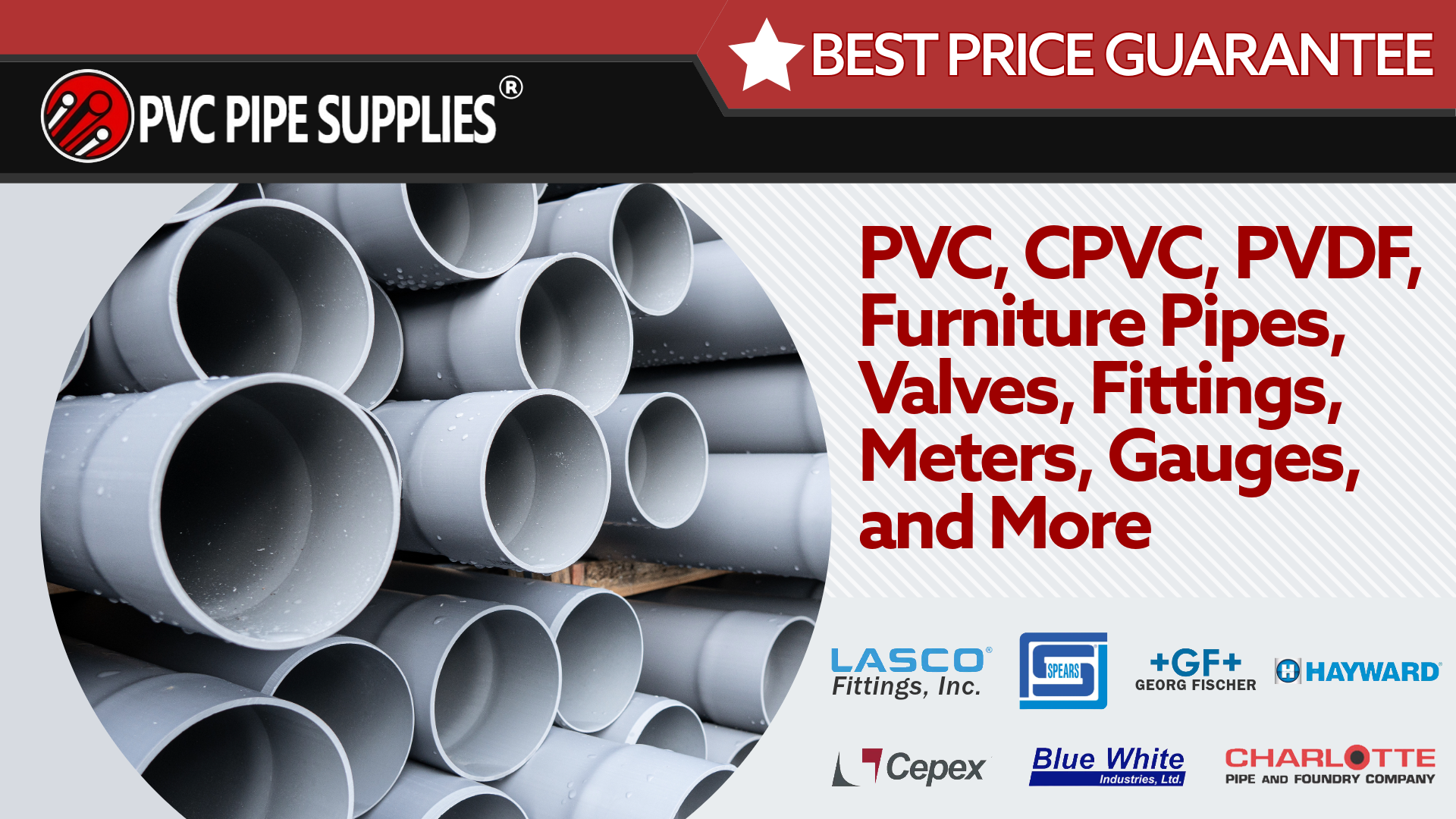 |
Buy Quality Pipe Products from Quality SuppliersFrom understanding the differences between Schedule 40 and Schedule 80 to installation techniques, DIY projects, and more, this guide has covered the essential questions about PVC pipes and fittings. We've highlighted PVC's proven reliability, impressive service life, unmatched versatility, and provided you with the best practices to ensure your projects are successful and built to last. Whether you are a seasoned contractor or a dedicated DIYer, having the right information and the right products is key to professional results. Your projects deserve the best materials and expert support. If you have more questions or need guidance on selecting the perfect parts for your needs, our team is here to help. Explore our product catalog, our collection of resources, or contact us directly for personalized assistance. |


Buy Quality Pipe Products from Quality Suppliers
From understanding the differences between Schedule 40 and Schedule 80 to installation techniques, DIY projects, and more, this guide has covered the essential questions about PVC pipes and fittings. We've highlighted PVC's proven reliability, impressive service life, unmatched versatility, and provided you with the best practices to ensure your projects are successful and built to last. Whether you are a seasoned contractor or a dedicated DIYer, having the right information and the right products is key to professional results.
Your projects deserve the best materials and expert support. If you have more questions or need guidance on selecting the perfect parts for your needs, our team is here to help. Explore our product catalog, our collection of resources, or contact us directly for personalized assistance.
